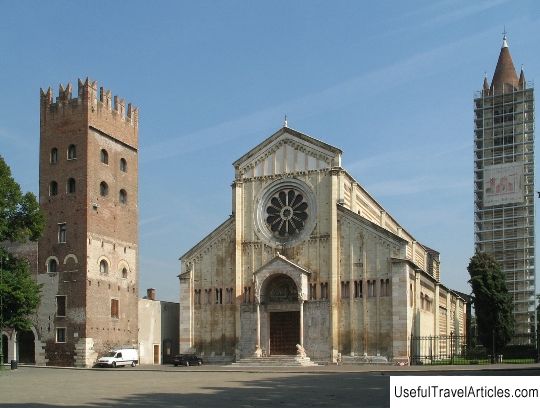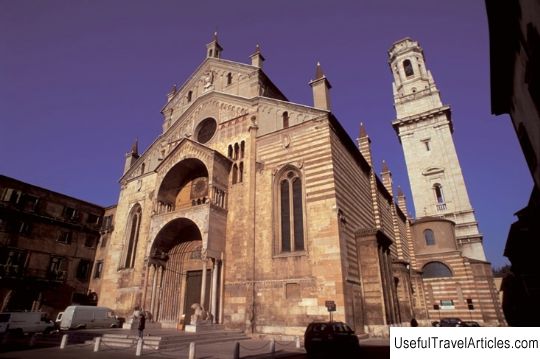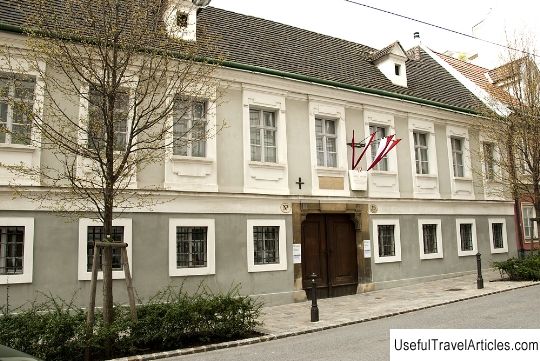Basilica di San Zeno Maggiore description and photos - Italy: Verona
Rating: 8,0/10 (310 votes) 
Basilica di San Zeno Maggiore description and photos - Italy: Verona. Detailed information about the attraction. Description, photographs and a map showing the nearest significant objects. The title in English is Basilica di San Zeno Maggiore. Photo and descriptionThe Basilica of San Zeno Maggiore is one of the most beautiful Romanesque churches in Verona, built on the burial place of the patron saint of the city, Zinon of Verona, who was also the first local bishop. Saint Zenon died at the end of the 4th century, and several decades later a small church was built over his grave by the order of the Emperor Theodoric the Great. It existed for about four centuries, until it was destroyed in 807, and a new temple appeared in its place, in which the relics of Zinon were placed. This church stood even less - at the beginning of the 10th century, during the Hungarian invasion, it was almost completely destroyed, and the relics of the saint were transferred to the cathedral. From there, in 921, they were returned to the crypt - the only surviving structure of the church. The construction of the current building of the basilica was completed in the second half of the 10th century by decree of Emperor Otto the Great, and a bell tower was built in the 11th century. Despite the fact that the building was badly damaged by the earthquake of 1117, it was already restored by 1138. At the end of the 14th century, the next renovation work was carried out here - the roof was replaced, the ceiling of the central nave was created and the apse in the Gothic style was added. Then, for a long time, the temple was half-abandoned, and in the early 1800s it was in a depressing state. Its complete restoration was completed only in 1993. The current building of the basilica was built of local volcanic tuff with rare marble intersperses, which are decorated with bas-reliefs on the theme of the Last Judgment. The author of these bas-reliefs, which today, unfortunately, are poorly distinguishable, - sculptor Brioloto. He also created a round rosette window in the center of the facade, called the "Wheel of Fortune". The entrance to the church is decorated with a Gothic portal, created in the 12th century by the master Nicolo, who also worked on the portal of the Cathedral of Verona. The columns of the portico support the figures of lions, which are tearing apart the prey, and the portico itself is decorated with sculptures of John the Evangelist, John the Baptist and images of the 12 months of the year. Here you can also see the image of St. Zeno, surrounded by foot and horse soldiers. On the sides of the main entrance in 4 tiers there are 16 bas-reliefs made on the subjects of the Old and New Testaments, as well as depicting medieval knightly scenes. The gates of the basilica are faced with bronze panels with biblical subjects, some of which are already about 900 years old! The interior of the temple is striking in its luxury: here you can see a 12th century baptismal font carved from a single piece of marble, a carved stone altar, 13-15th century frescoes and other works of art, including the famous triptych by Andrea Mantegna "Madonna enthroned with angels and saints." One of the naves contains a huge porphyry bowl, discovered during excavations of ancient Roman baths. And in the crypt, in a crystal reliquary, are the relics of Saint Zenon. Next to the basilica is a 12th century cloister, whose galleries consist of numerous double columns with arches. Several medieval tombstones can be seen here, including a tombstone of one of the members of the Scaliger family, created in 1313. A little further is the Church of San Procolo, which houses the relics of the fourth bishop of Verona, St. Proclus. It was built in the 6-7 centuries, however, completely redesigned after the 1117 earthquake. Finally, in the immediate vicinity of the Basilica of San Zeno are the ruins of a small monastery built in the 9th century and destroyed during the Napoleonic Wars. Only a huge brick tower and cloisters have survived.          We also recommend reading Holy Dormition Monastery description and photos - Russia - Golden Ring: Ivanovo Topic: Basilica di San Zeno Maggiore description and photos - Italy: Verona. |




